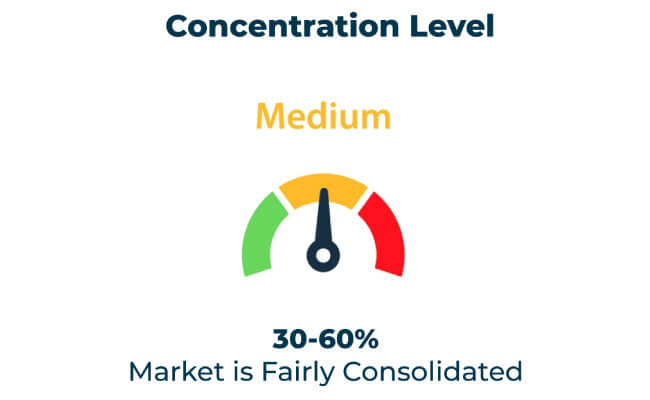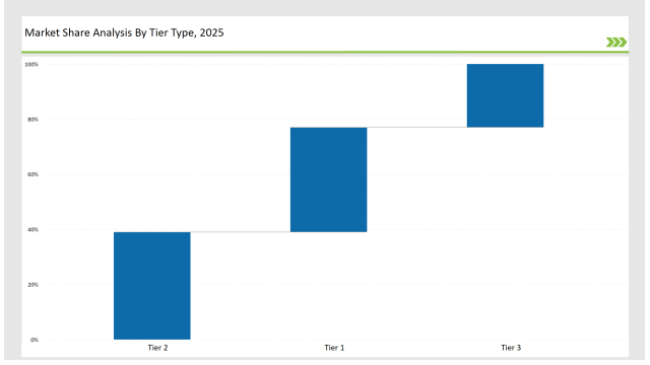The wine box industry is growing rapidly as consumers and businesses seek more sustainable, cost-effective, and innovative packaging solutions for wine storage and distribution. Companies are investing in recyclable materials, premium design enhancements, and eco-friendly innovations to meet evolving consumer demands and regulatory expectations.
Leading manufacturers are focusing on biodegradable packaging, smart tracking solutions, and enhanced barrier technology to improve product preservation while minimizing environmental impact. The demand for both commercial and retail sectors is fast-paced due to the shift in sustainable, aesthetic, and functional packaging.
The Tier 1 players, like Smurfit Kappa, WestRock, and DS Smith, dominate with a 38% market share by using excellent global distribution networks, innovative designs, and agreements with premium wineries and retail chains.
Tier 2 manufacturers, including Liquibox, Scholle IPN, and Rapak, capture 39% of the market. These companies focus on cost-efficient and customizable wine box solutions, catering to mid-sized and emerging wine brands.
Tier 3 competitors, such as BiB Wine, CDF Corporation, and niche regional players, hold 23% of the market by specializing in eco-friendly, customizable, and small-batch wine packaging solutions.
Exclusive Offer: 30% Off on Regional Reports
Get a free sample report and customize your regions for a 30% discount on your regional report!
Global Market Share by Key Players (2025)
| Category | Market Share % |
|---|---|
| Top 3 (Smurfit Kappa, WestRock, DS Smith) | 19% |
| Rest of Top 5 (Liquibox, Scholle IPN) | 12% |
| Next 5 of Top 10 (Rapak, BiB Wine, CDF Corporation, Amcor, Goglio) | 7% |

The wine box market is expanding as industries and consumers seek innovative, sustainable, and efficient packaging solutions
Manufacturers are differentiating themselves through material innovation, sustainability efforts, and smart packaging solutions
The industry is growing with great improvements in eco-friendly packaging, premium aesthetics, and smart packaging. Companies are developing lightweight solutions that are recyclable with better barrier properties for the wine to stay fresh for longer periods and with a lesser carbon footprint. Brands are moving to feature high-end artistic premium aesthetics on new marketing boundaries through interactive storytelling and QR codes that can be scanned to verify authenticity.
Year-on-Year Leaders
Technology providers should focus on automation, sustainability, and digital engagement solutions to meet growing industry demands. Collaborating with wineries and retailers will accelerate adoption of smart packaging innovations.
Check Free Sample Report & Save 40%!
Select your niche segments and personalize your insights for smart savings. Cut costs now!
| Tier Type | Example of Key Players |
|---|---|
| Tier 1 | Smurfit Kappa, WestRock, DS Smith |
| Tier 2 | Liquibox, Scholle IPN, Rapak |
| Tier 3 | BiB Wine, CDF Corporation, Goglio |

Leading manufacturers are enhancing sustainability, automation, and premium branding in the wine box industry.
| Manufacturer | Latest Developments |
|---|---|
| Smurfit Kappa | Introduced biodegradable and lightweight premium wine boxes in July 2024. |
| WestRock | Launched recyclable bag-in-box solutions with high-barrier films in April 2024. |
| DS Smith | Developed smart wine boxes featuring QR-code-enabled customer interaction in September 2024. |
| Liquibox | Expanded ultra-durable bag-in-box offerings for wineries in May 2024. |
| Scholle IPN | Innovated compostable wine pouches designed for sustainability-conscious consumers in November 2024. |
The wine box industry is rapidly evolving as sustainability, digital innovation, and premium branding drive competition:
Packaging for the future of wine will be more related to automation, sustainability, and digital interaction. Material selection using AI, blockchain-supported authentication, and compostable wine packaging are set to redefine industry standards. The creative solutions for packaging that meet both luxury consumerism and sustainability-conscious buyers will be designed so that an engaging, ecologically friendly, and thorough wine experience will be preserved.
The companies will advance lightweight and durable materials with lower shipping costs and better logistics efficiency. Enhanced digital labeling will provide real-time product tracking for consumers, resulting in increased transparency and trust of purchases.
Leading players include Smurfit Kappa, WestRock, DS Smith, Liquibox, and Scholle IPN.
The top 3 players collectively hold 19% of the global market.
The market shows medium concentration, with top players holding 38%.
Key drivers include sustainability, smart packaging, and premium branding innovations.
Explore Function-driven Packaging Insights
View Reports
Thank you!
You will receive an email from our Business Development Manager. Please be sure to check your SPAM/JUNK folder too.